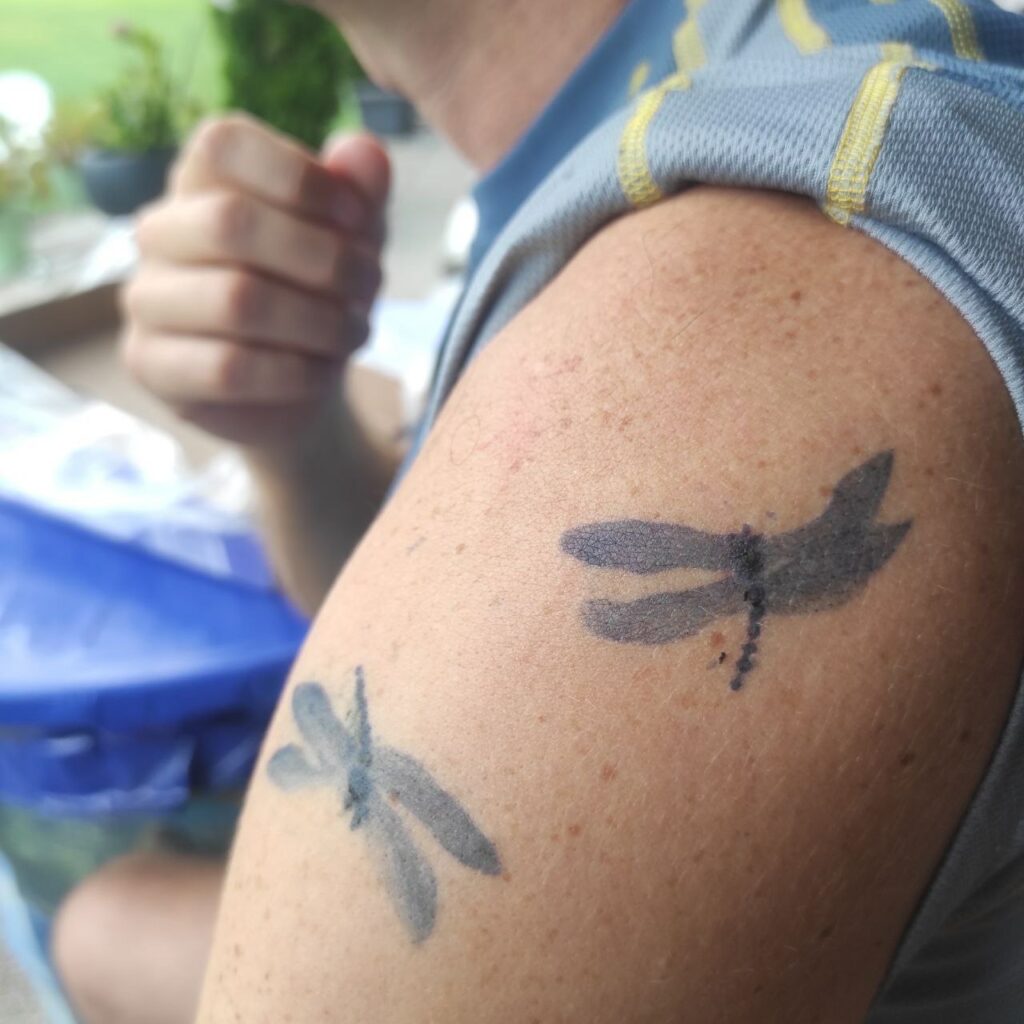- Difference between Red, Brown and Black Henna
- How Long to leave Henna Paste on the Skin
- remove the dry Henna Paste
- Difference in Applying Jagua compared to Henna
- Common Pitfalls when Preparing Henna
- What Skin Types can use Henna
- What Skin Types is Jagua suitable for
- Good Aftercare
- Greatest Effect
- Can I sunbathe with Henna- / Jagua
- Known Allergic Reactions
- From what Age suitable
What is the Difference between Red, Brown and Black Henna?
Red or brown henna is a natural pigment that comes from the henna tree Lewsonia inermis and is mixed with various other exclusively natural substances – such as 100% essential oils, sugar, etc. – in the henna paste. This way you know exactly what it contains and it is safe for skin application.
Black henna can come from the henna plant Lewsonia inermis, but the exact composition of the dye is not specified, and terpenes from essential oils that fix and influence the pigment colour are replaced by more stable, chemically synthesised p-phenylenediamine (PPD), which can cause severe allergic reactions and skin burns and is therefore also banned as a cosmetic product in many countries.
How Long do you leave the natural Henna Paste on the Skin?
It is important that the henna paste dries and hardens on the skin before it is removed to achieve the best result.
It is better to leave the paste on the painted skin as long as possible to achieve a more intense colouring. The pigment will already be visible after the paste has dried on the skin and been rubbed off. For a better result, if the colour is already dry, it is better to leave it on the skin for another five to eight hours – better still overnight – covered with a plaster.
What is the Best Way to remove the dry Henna Paste?
You can rub the henna paste off with your fingers or a credit card, pencil or other blunt objects when it is dry, or if it is plastered over, it will come off with plaster.
It is recommended that you do not use water on the painted area for at least eight hours after painting to achieve the best possible colouring of the skin.
What is the Perfect Consistency to apply the Henna Paste?
The perfect consistency of henna is not too runny, otherwise, it will smear the colour on the skin. The consistency should also not be too thick, because it will be difficult to push the paste through the thin cone opening, which in turn will prevent you from achieving the correct shapes for the henna ornament.
The consistency of the henna paste should be thick and smooth, similar to the consistency of toothpaste or pancake batter. It is important to mix the henna paste thoroughly to achieve a homogeneous consistency.
What is the Difference in Applying Jagua compared to Henna?
Jagua and henna are two different natural dyes.
Jagua is not a paste, but a gel. This means it is not as easy to apply evenly to the skin as henna, it runs more easily and makes clear contours difficult.
You also have to be careful not to smudge the jagua or spread it on another area, as it can leave an imprint on the skin.
The gel is left on the skin for about one to two hours. The deep blue-to-black discolouration is delayed. It is best to dab the jagua paste with a paper towel after it dries to avoid smudging.
What are the Most Common Pitfalls when Preparing Henna?
Use only high-quality henna powder from trusted sources. Wear disposable gloves when preparing, otherwise, your fingers may discolour the areas you touch. It is important to add water and essential oils successively when mixing and generally not to let it become too liquid. The right amount of ingredients is the secret to finding the perfect consistency for applying to the skin.
Do not use metallic bowls and spoons as they can react with the henna dye and distort it.
The henna paste needs time to mature and develop a dark colour. It is recommended to let the henna paste rest for at least four hours, better still overnight, to achieve a deeper colour. You can freeze the unused henna to stop the natural oxidation process.
What Skin Types can use Henna?
Henna can be used for all skin types. If you are unsure, you can do a patch test before applying the henna paste or jagua. This involves first applying a sample of the henna paste or jagua gel to the skin on the inside of the wrist for 24 hours. You then check the area for any redness, swelling or itching.
What Skin Types is Jagua suitable for?
Jagua can be applied to all skin types.
Only prolonged direct sun exposure to the Jagua ornament may cause a reaction to the sun’s rays in more sensitive skin.


What is Good Aftercare?
With henna, it is better not to wash the area with water for a few hours directly after applying the henna paste. For a perfect effect, wait about eight hours after dyeing until the skin comes into contact with water. A simple trick to protect the applied area from water is to apply a little shea butter. For long-lasting and intense colouring, do not use brushes or soaps on the area.
Where do Henna and Jagua have the Greatest Effect?
Henna and Jagua have their greatest effect on the top layer of the skin, the so-called epidermis.
The darkest colour of your ornament is achieved on the areas of the skin where the skin is strongest. Henna and jagua dye the surface of the skin by binding to proteins in the topmost skin cells. Therefore, the best effect is on the palms or feet, but the backs of the hands and legs also colour well.
Henna is traditionally used for temporary ornaments on hands and feet, which usually have more blood flow and are warmer, as heat accelerates colour development.
Jagua is bluish-black in colour intensity and is used for body art on forearms, wrists, feet and other parts of the body.
The combination of henna and jagua creates a particularly appealing colour contrast.
Can I sunbathe with Henna- / Jagua-Ornament?
Jagua in moderate sunlight does not affect the intensity of the ornament.
Intens sunlight and UV light may cause the intensity of the henna ornament to fade more quickly, sunscreen or clothing on the area may prevent this.
Are there any Known Allergic Reactions when using Henna or Jagua?
In very rare cases, allergic reactions can occur even with natural-based henna.
To be sure, you can do a patch test.
It is important to use only natural henna dyes from trustworthy sources to exclude PPD.
In rare cases, lemon juice or essential oil added to natural henna may slightly irritate the skin. It is then recommended to use neutral lavender oil, which pregnant women can also use to paint their baby bumps.
Jagua without chemical ingredients can in rare cases – with sensitive skin – cause a slight sun allergy after prolonged exposure to the sun. This is not common but may appear as a reddish rash if the skin is allergic to the sun. This disappears within a few days.
From what Age are Henna and Jagua suitable?
From any age, for people – children and adults who can hold still for a while and do not smear the henna paste or jagua gel.
